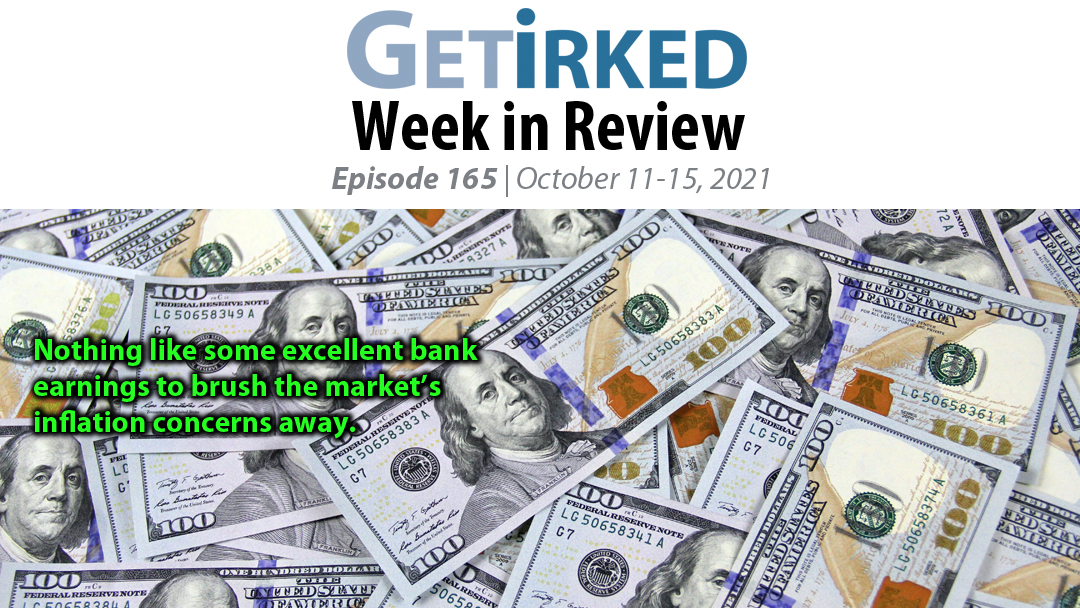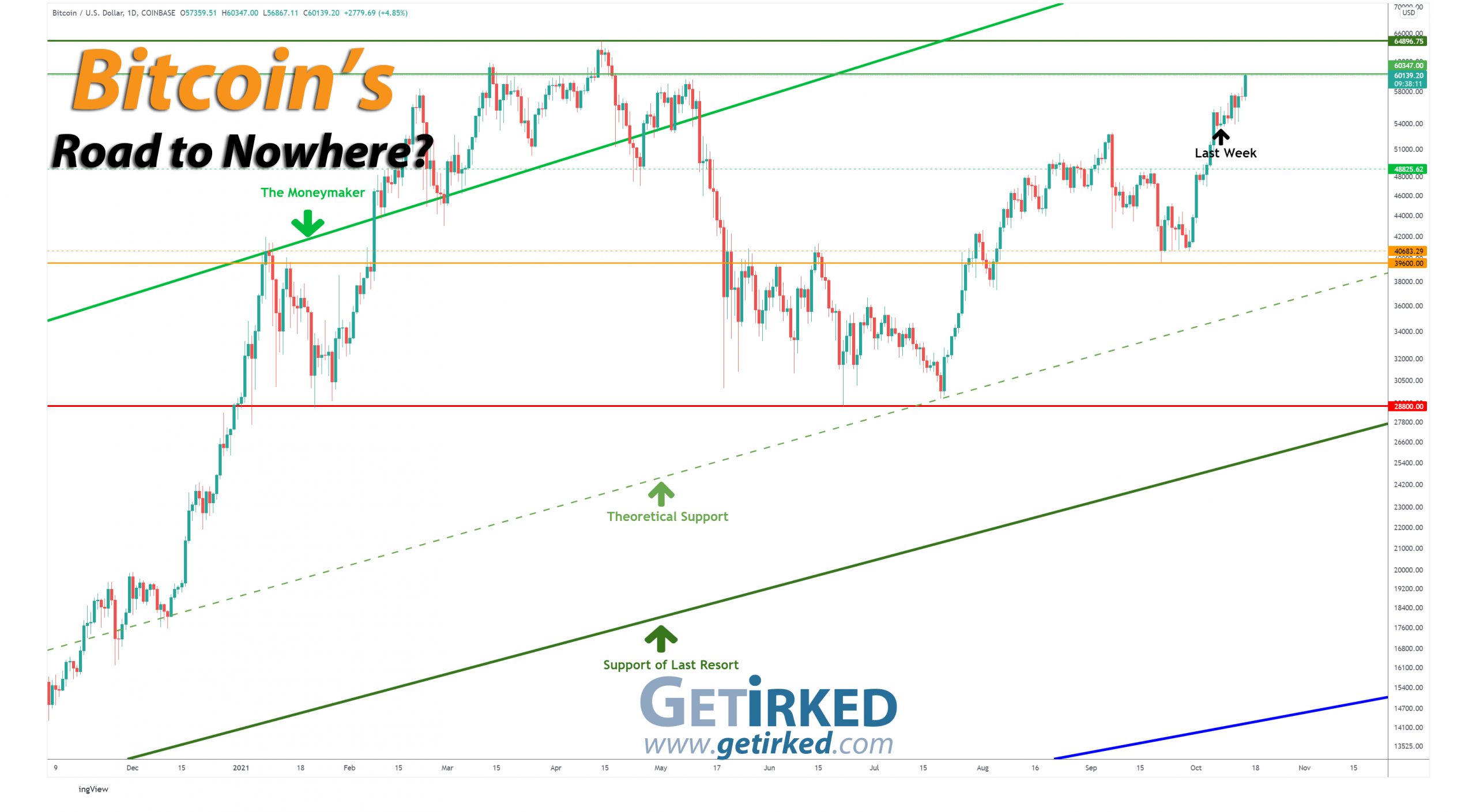Summing Up The Week
While inflation and economic news weighed on the markets early in the week, all was forgotten once Earning Season started with a bang. Banks reported excellent earnings, giving investors hope that the rest of the market would follow suit.
Let’s take a look at the news that moved the markets this week…
Market News
IMF warns of inflation, recommends tightening policy
On Tuesday, the International Monetary Fund (IMF) warned that central banks around the world such as the Fed should be prepared to tighten policy in case inflation gets out of control, reported CNBC.
While the IMF agreed with current assessments from the U.S. Federal Reserve Bank, it noted “high uncertainty” around the forcecasts. “While monetary policy can generally look through transitory increases in inflation, central banks should be prepared to act quickly if the risks of rising inflation expectations become more material in this uncharted recovery,” said Gita Gopinath, the IMF’s Economic Counselor and Director of Research. “Central banks should chart contingent actions, announce clear triggers, and act in line with that communication.”
However, the CEOs of many U.S. banks, including JPMorgan Chase (JPM) CEO Jamie Dimon, see inflation cooling, as he said on Monday that he expects supply chain issues contributing to price surges to clear up in 2022.
4.3M workers quit their jobs in August
On Tuesday, the Labor Department’s Job Openings and Labor Turnover Survey (JOLTS) revealed 4,300,000 American workers quit their jobs in August – primarily due to child care issues or health concerns, reported CNBC.
Historically, economists view the number of people quiting as a level of confidence from workers secure in finding jobs elsewhere, however, things have changed thanks to COVID-19 and the pandemic response.
The “quits rate” rose to 2.9%, an increase of 242,000 from the previous month and the highest rate in the data series stretching back more than 20 years to December 2020.
Naturally, the JOLTS report lags the nonfarm payroll report by a month, so whether or not this data is currently relevant remains to be seen.
Consumer prices rise more than expected in September
On Wednesday, the Labor Department reported that the Consumer Price Index (CPI) rose 0.4% in September versus the 0.3% expected by Dow Jones economists, reported CNBC. On a year-over-year basis, consumer prices have increased 5.4% versus the estimate for 5.3%, the highest since January 1991.
While the market didn’t initially react to the increase in negative inflationary news, Wednesday’s report certainly piled on with warnings from the IMF earlier in the week.
Fed tapering to start in November
On Wednesday, the Federal Reserve indicated it will start tapering its asset purchases beginning with a monthly reduction of $10 billion in Treasurys and $5 billion in mortgage-backed securities beginning in November, reported CNBC after the Fed released its minutes and summary from the September meeting.
Barring additional “disruptions,” the target date to end purchases completely would be in mid-2022.”Participants generally assessed that, provided that the economic recovery remained broadly on track, a gradual tapering process that concluded around the middle of next year would likely be appropriate,” noted the minutes.
“Participants noted that if a decision to begin tapering purchases occurred at the next meeting, the process of tapering could commence with the monthly purchase calendars beginning in either mid-November or mid-December,” the summary also said.
As the tapering process was widely expected, the markets reacted very little to the minutes, remaining generally flat on Wednesday.
Positive bank earnings cause market rally
While JPMorgan Chase’s (JPM) earnings were good, its forecast was not, so markets didn’t react until Bank of America (BAC) reported great earnings on Thursday, followed by Goldman Sachs (GS) crushing analysts’ estimates on strong investment banking and trading results (CNBC) on Friday.
While inflation risks and potential tightening of Fed policy can weigh down the market, nothing can bring back the bullish spirits like the promise of great results in the form of excellent earnings and guidance. Markets rallied on Thursday and Friday in hopes that the rest of the market’s reports would be as good as the banks.
Next Week’s Gameplan
It’s hard to believe that the seasonal weakness so typical this time of the year has suddenly been sloughed off by a few earnings reports from the financial sector.
Regardless, the plan remains the same – keep an eye on potential buying and profit-taking targets for all positions, and take advantage of the seasonal volatility.
This Week in Play
Stay tuned for this week’s episodes of my two portfolios Investments in Play and Speculation in Play coming online later this weekend!
Crytpo Corner
Important Disclaimer
Get Irked contributors are not professional advisers. Discussions of positions should not be taken as recommendations to buy or sell. All investments carry risk and all readers must accept their own risks. Get Irked recommends anyone interested in investing or trading any asset class consult with a professional investment adviser to determine if an investment idea is suitable to them and their investment goals.
Click chart for enlarged version
Bitcoin Price (in USD)
%
Weekly Change
Bitcoin Price Action
Will Bitcoin make another new All-Time-High in 2021?
Bitcoin continued its bull run this week on hopes that Bitcoin ETFs may finally make their debut to the trading public next week, reported CNBC. The past several weeks of bullish price action have confounded many bears as the crypto made a new weekly high of $60,347.00 just today.
The Bullish Case
Bulls believe the bottom of $28,800 made earlier in summer 2021 represents the low of this bear cycle. Many bullish pundits believe we will see Bitcoin break its all-time high of $64,896.75 within the next few weeks when/if the Bitcoin Exchange-Traded Funds (ETFs) launch.
The Bearish Case
Bears remain skeptical, telling many that the macro bear move isn’t over until Bitcoin can break its all-time high. Additionally, bearish pundit point to the launch of Bitcoin ETFs as a “buy-the-rumor, sell-the-news” event. In other words, traders will buy up the price of Bitcoin into the announcement of crypto ETFs, but will take profits once the ETFs are made official.
Bitcoin Trade Update
Still no trade, yet.
Given that the current bull rally is basically unheard of when looking at Bitcoin’s historical movements, I’m staying hands-off at this point. Since I always keep my profits in crypto, I get to enjoy bull moves like this without feeling as much FOMO.
Sure, I’d love to have had a trade on to capture some of this amazing move, but since it’s so difficult to figure out where Bitcoin may move from here, I’d rather sit on my hands and watch the price action than get in too early and have my face ripped off.
Bitcoin Buying Targets
Using Moving Averages and supporting trend-lines as guides, here is my plan for my next ten (10) buying quantities and prices:
0.542% @ $40,887
0.542% @ $36,370
0.542% @ $32,087
0.542% @ $28,829
1.370% @ $24,720
2.146% @ $21,722
1.749% @ $20,385
1.763% @ $19,418
2.935% @ $18,178
4.131% @ $14,869
No price target is unrealistic in the cryptocurrency space – Bullish or Bearish.
While traditional stock market investors and traders may think the price targets in the cryptocurrency space are outlandish due to the incredible spread (sometimes a drop of near -90% or a gain of up to +1000% or more), Bitcoin has demonstrated that, more than any speculative asset, its price is capable of doing anything.
Here are some of Bitcoin’s price movements over the past couple of years:
- In 2017, Bitcoin rose +2,707% from its January low of $734.64 to make an all-time high of $19,891.99 in December.
- Then, Bitcoin crashed nearly -85% from its high to a December 2018 low of $3128.89.
In the first half of 2019, Bitcoin rallied +343% to $13,868.44. - From June 2019, Bitcoin crashed -54% to a low of $6430.00 in December 2019.
- From December 2019’s low, Bitcoin rallied +64% to $10,522.51 in February 2020.
- In March 2020, Bitcoin crashed nearly -63% to a low of $3858.00, mostly in 24 hours.
- Then, Bitcoin rallied +988% to a new all-time high of $41,986.37 in January 2021.
- Later in January, Bitcoin dropped -32% to a low of $28,732.00.
- In February 2021, Bitcoin rallied +103% to a new all-time high of $58,367.00.
- Later in February, Bitcoin dropped -26% to a low of $43,016.00.
- In March 2021, Bitcoin rallied +44% to a new all-time high of $61,788.45.
- Later in March, Bitcoin dropped -19% to a low of $50,305.00.
- In April 2021, Bitcoin rallied +29% to a new all-time high of $64,896.75.
- In June 2021, Bitcoin crashed -56% to a low of $28,800.00.
Where will Bitcoin go from here? Truly, anything is possible…
What if Bitcoin’s headed to zero?
The only reason I speculate in the cryptocurrency space is I truly believe Bitcoin isn’t headed to zero.
I am prepared for that possibility, however, by knowing I could potentially lose all of the capital I’ve allocated to this speculative investment. Professional advisers recommend speculating with no more than 5% of an investor’s overall assets. Personally, I’ve allocated less than that to speculating in crypto.
I feel that anyone who doesn’t fully believe in the long-term viability of cryptocurrency would be better served not speculating in the space.
On a good day, this asset class isn’t suitable for those with weak stomachs. On volatile days, the sector can induce nausea in the most iron-willed speculator. If a speculator isn’t confident in the space, the moves will cause mistakes to be made.
DISCLAIMER: Anyone considering speculating in the crypto sector should only do so with funds they are prepared to lose completely. All interested individuals should consult a professional financial adviser to see if speculation is right for them. No Get Irked contributor is a financial professional of any kind.
Ways to give back to GetIrked:
Send me a tip via Stripe! Thank you!
Get free money by signing up for an account with my referral link for Schwab
Sign up for Gemini and we each get $10
Click this referral link to get the Brave Browser
If you use Brave, you can also use the Tip function to tip me in Basic Attention Token (BAT).
Suicide Hotline – You Are Not Alone
Studies show that economic recessions cause an increase in suicide, especially when combined with thoughts of loneliness and anxiety.
If you or someone you know are having thoughts of suicide or self-harm, please contact the National Suicide Prevention Lifeline by visiting www.suicidepreventionlifeline.org or calling 1-800-273-TALK.
The hotline is open 24 hours a day, 7 days a week.


